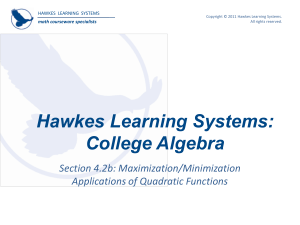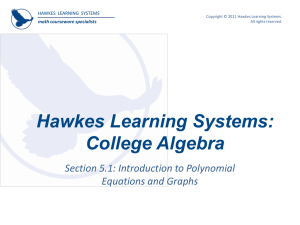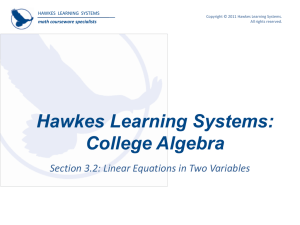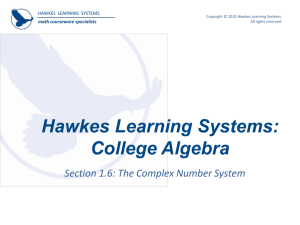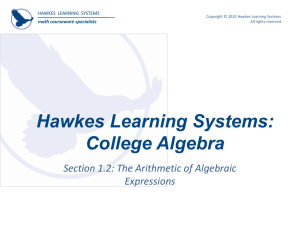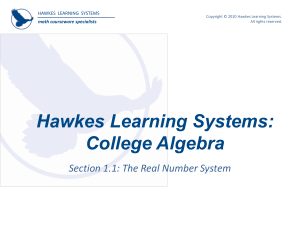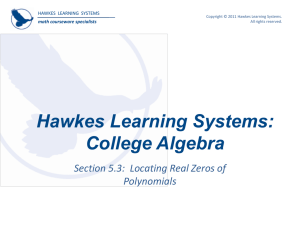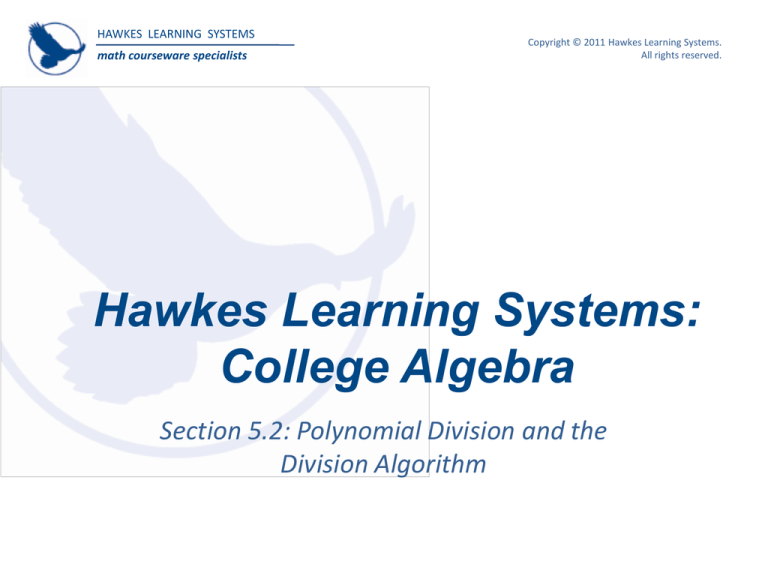
HAWKES LEARNING SYSTEMS
math courseware specialists
Copyright © 2011 Hawkes Learning Systems.
All rights reserved.
Hawkes Learning Systems:
College Algebra
Section 5.2: Polynomial Division and the
Division Algorithm
HAWKES LEARNING SYSTEMS
Copyright © 2011 Hawkes Learning Systems.
All rights reserved.
math courseware specialists
Objectives
o The Division Algorithm and the Remainder Theorem.
o Polynomial long division and synthetic division.
o Constructing polynomials with given zeros.
HAWKES LEARNING SYSTEMS
math courseware specialists
Copyright © 2011 Hawkes Learning Systems.
All rights reserved.
The Division Algorithm
Let p x and d x be polynomials such that d x 0 and
with the degree of d x less than or equal to the degree of
p x . Then there are unique polynomials q x and r x ,
called the quotient and the remainder, respectively, such
that
p x q x d x r x .
dividend quotient divisor
remainder
The degree of the remainder, r x , is less than the degree
of the divisor, d x , or else the remainder is 0, in which
case we say d x divides evenly into the polynomial p x .
If the remainder is 0, the two polynomials q x and d x
are factors of p x .
HAWKES LEARNING SYSTEMS
math courseware specialists
Copyright © 2011 Hawkes Learning Systems.
All rights reserved.
The Division Algorithm
If we divide every term in p x q x d x r x by
the polynomial d x , we obtain the form:
p x
r x
q x
.
d x
d x
This fact may be stated, “If one polynomial is divided by
another of smaller degree, the result is a polynomial
plus, possibly, a ratio of two polynomials, the
numerator of which has a smaller degree than the
denominator.”
HAWKES LEARNING SYSTEMS
math courseware specialists
Copyright © 2011 Hawkes Learning Systems.
All rights reserved.
Zeros and Linear Factors
The number k is a zero of a polynomial p x if and only
if the linear polynomial x k is a factor of p. In this
case p x q x x k for some quotient polynomial
q. This also means that k is a solution of the polynomial
equation p . x 0 , and if p is a polynomial with real
coefficients and if k is a real number, then k is an xintercept of p.
HAWKES LEARNING SYSTEMS
math courseware specialists
Copyright © 2011 Hawkes Learning Systems.
All rights reserved.
The Remainder Theorem
If the polynomial p x is divided by x k , the
remainder is p k . That is,
p x q x x k p k .
HAWKES LEARNING SYSTEMS
math courseware specialists
Copyright © 2011 Hawkes Learning Systems.
All rights reserved.
Polynomial Long Division
Polynomial long division is the analog of numerical
long division, and provides the means for dividing any
polynomial by another of equal or smaller degree.
HAWKES LEARNING SYSTEMS
math courseware specialists
Copyright © 2011 Hawkes Learning Systems.
All rights reserved.
Example 1: Polynomial Long Division
Divide the polynomial 9 x5 10 x4 18x3 28x2 x 3 by the
polynomial 9 x2 x 1.
x3
9 x2 x 1 9 x5 10 x 4 18x3 28x 2 x 3
The first step is to
arrange the dividend
9x5 x 4 x3
and the divisor in
descending order.
9x 4 19x3 28x2 x 3
The first term of the
quotient is then the
first term of the
2
3
9
x
x 1 to
x
Then,
multiply
by
dividend divided by
obtain 9x5 x 4 x3 .
the first term of the
Subtract 9x5 x 4 x3 from the
divisor, giving us x 3 .
dividend.
HAWKES LEARNING SYSTEMS
math courseware specialists
Copyright © 2011 Hawkes Learning Systems.
All rights reserved.
Example 1: Polynomial Long Division (Cont.)
x3
x 2 2x 3
To determine the
9 x2 x 1 9 x5 10 x 4 18x3 28x 2 x 3
second term of the
quotient, we repeat
9x5 x 4 x3
the previous process.
9x 4 19x3 28x2 x 3
We will continue to
repeat this process
9x 4 x3 x2
until we are no longer
3
2
18
x
29
x
x3
able to divide the
18x3 2x 2 2x
dividend by the
divisor.
27 x2 3x 3
27 x 2 3 x 3
0
HAWKES LEARNING SYSTEMS
math courseware specialists
Copyright © 2011 Hawkes Learning Systems.
All rights reserved.
Polynomial Long Division
Caution!
Although polynomial long division is a straightforward
process, one common error is to forget to distribute the
minus sign in each step as one polynomial is subtracted
from the one above it. A good way to avoid this error is
to put parentheses around the polynomial being
subtracted, as in Example 1.
HAWKES LEARNING SYSTEMS
Copyright © 2011 Hawkes Learning Systems.
All rights reserved.
math courseware specialists
Synthetic Division
Synthetic division is a shortened version of polynomial
long division, and can be used when the divisor is of
the form x k for some constant k .
Synthetic division does not do anything that long
division can’t do (and in fact is only applicable in certain
circumstances), but the speed of synthetic division is
often convenient.
Instead of various powers of the variable, synthetic
division uses a tabular arrangement to keep track of the
coefficients of the dividend and, ultimately, the
coefficients of the quotient and remainder.
HAWKES LEARNING SYSTEMS
Copyright © 2011 Hawkes Learning Systems.
All rights reserved.
math courseware specialists
Synthetic Division
Compare the division of 2 x3 8x2 9 x 7 by x 2 below,
using long division on the left and synthetic division on the right.
2 x2 4 x 1
x 2 2 x3 8 x 2 9 x 7
2x3 4 x 2
4 x2 9 x 7
4x 2 8 x
x 7
x 2
5
2 2 8 9 7
4 8 2
2 4 1 5
Note: the numbers in blue are the
coefficients of the dividend and the
numbers in pink are the coefficients
of the quotient and remainder.
HAWKES LEARNING SYSTEMS
Copyright © 2011 Hawkes Learning Systems.
All rights reserved.
math courseware specialists
Synthetic Division
Step 1: Write k and the coefficients of the dividend.
Copy the leading coefficient of the dividend in the first
slot below the horizontal line.
Step 2: Multiply this number by k and write the result
directly below the second coefficient of the dividend.
Step 3: Add the two numbers in that column and write
the result in the second slot below the horizontal line.
Step 4: Repeat the process until the last column is
completed and the last number written down is the
remainder.
Continued on the next slide…
HAWKES LEARNING SYSTEMS
Copyright © 2011 Hawkes Learning Systems.
All rights reserved.
math courseware specialists
Synthetic Division
The other numbers in the bottom row constitute the
coefficients of the quotient, which will be a polynomial
of one degree less than the dividend.
For example,
2
2
8
9
2 4 2 8 2
2
4
1
7
2
5
HAWKES LEARNING SYSTEMS
Copyright © 2011 Hawkes Learning Systems.
All rights reserved.
math courseware specialists
Synthetic Division
Because synthetic division is much faster than long
division, it is very useful in determining if x k is a
factor of a given polynomial.
By the remainder theorem, synthetic division also
provides a quick means of determining p k for a
given polynomial p x since p k is the remainder
when p x is divided by x k .
HAWKES LEARNING SYSTEMS
math courseware specialists
Copyright © 2011 Hawkes Learning Systems.
All rights reserved.
Example 2: Synthetic Division
Determine if the given k is a zero. If not, determine p k .
p x 2 x8 10 x7 x 4 25 x 2 x 3;
k 5
Note: It is essential that we place a number of 0’s in certain slots in
the first row, as these serve as placeholders for the missing terms
of the dividend (namely x 6 , x 5 , and x 3 ).
5 2 10 0 0 1 0 25 1 3
10 0 0 0 5 25 0 5
2 0 0 0 1 5 0 1 8
The fact that the last number is non-zero means 5 is not a zero
of p. We can conclude that p 5 8.
HAWKES LEARNING SYSTEMS
Copyright © 2011 Hawkes Learning Systems.
All rights reserved.
math courseware specialists
Example 3: Synthetic Division
Determine if the given k is a zero. If not, determine p k .
p x 2 x3 x 2 25 x 12;
k4
2 1 25 12
8 28 12
3
0
2 7
2
p x 2x 7 x 3 x 4
4
In this case, the remainder is 0, and hence 4 is a zero of
the polynomial p. Since the remainder is 0, we now know
of two factors of p, as illustrated above.
HAWKES LEARNING SYSTEMS
math courseware specialists
Copyright © 2011 Hawkes Learning Systems.
All rights reserved.
Polynomial Long Division and Synthetic Division
When graphing polynomials, we will be concerned with
those that have only real coefficients, but complex
zeros and coefficients may still arise in intermediate
stages of the graphing process.
In solving polynomial equations, we have already seen
(in the case of quadratic equations) that complex
numbers may be the only solutions.
For these reasons, it is important for us to be able to
handle complex numbers as they arise.
HAWKES LEARNING SYSTEMS
Copyright © 2011 Hawkes Learning Systems.
All rights reserved.
math courseware specialists
Example 4: Polynomial Long Division
Divide p x x 2 1 by d x x i using polynomial
long division.
x i
Note: The term 0x
2
x i x 0x 1
exists as a
placeholder for the
x2 ix
missing x term in
ix 1
2
x
1.
ix 1
0
2
x
i
x
i
x
1
HAWKES LEARNING SYSTEMS
Copyright © 2011 Hawkes Learning Systems.
All rights reserved.
math courseware specialists
Example 5: Synthetic Division
Divide p x 2 x 3 5i x 3 9i by d x x 3i
using synthetic division.
2
3i
2
2
3 5i 3 9i
6i 3 9i
0
3 i
2
2
x
3
i
x
3
i
2
x
3 5i x 3 9i
HAWKES LEARNING SYSTEMS
math courseware specialists
Copyright © 2011 Hawkes Learning Systems.
All rights reserved.
Constructing Polynomials with Given Zeros
We now know the connection between zeros and
factors: k is a zero of the polynomial p x if and only if
x k is a factor of p x .
We can make use of this fact to construct polynomials
that have certain desired properties, as illustrated in
the following examples.
HAWKES LEARNING SYSTEMS
math courseware specialists
Copyright © 2011 Hawkes Learning Systems.
All rights reserved.
Example 6: Polynomials with Given Zeros
Construct a polynomial that has the given properties:
third degree, zeros of 4, 6, 1 and goes to as x .
p x x 4 x 6 x 1
p x x 3 3x 2 22 x 24
First, note that x 4, x 6, and x 1 must be factors of
the polynomial we are about to construct, since these
factors give rise to the desired zeros. Since a cubic with a
positive leading coefficient goes to as x , we must
multiply the three linear factors by a negative constant to
achieve the desired behavior.
HAWKES LEARNING SYSTEMS
Copyright © 2011 Hawkes Learning Systems.
All rights reserved.
math courseware specialists
Example 7: Polynomials with Given Zeros
Construct a polynomial that has the given properties:
fourth degree, zeros of 1, 3, 3, and 6, and a y-intercept
of 108 .
p x a x 1 x 3 x 3 x 6
Remember,
Because
thethe
linear factors
can
polynomial
has
a
multiplied by
y-intercept
of any
108,
non-zero
we
know constant
that
a without
p(0)
= 108.affecting
the zeros.
p 0 a 1 3 3 6
108 54a
2 a
p x 2 x 1 x 3 x 3 x 6
p x 2 x 14 x 6 x 126 x 108
4
3
2



